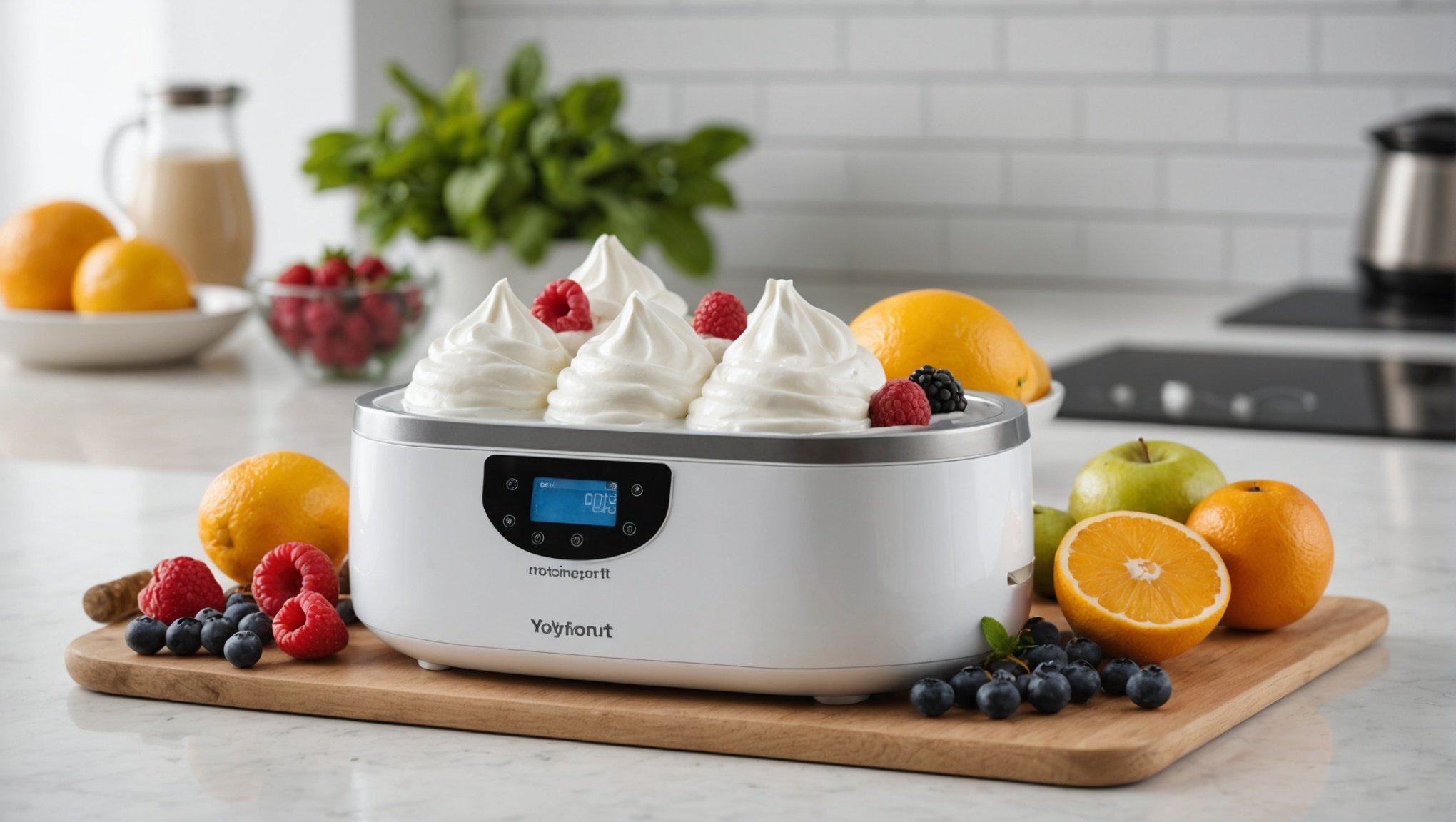A dedicated yogurt maker can elevate your calorie-conscious lifestyle in surprising ways. This handy kitchen appliance not only simplifies the process of making your own yogurt but also allows you to control ingredients and portion sizes. Imagine indulging in creamy, delicious yogurt tailored to your taste while keeping health in mind. Transforming your diet with homemade yogurt fosters better nutrition and saves you money. Discover how easy it is to incorporate this healthy habit into your daily routine and reap the benefits of enhanced well-being.
Benefits of Using a Dedicated Yogurt Maker
When considering the advantages of a yogurt maker, the health benefits of homemade yogurt stand out prominently. Unlike store-bought options, homemade yogurt allows you to control the ingredients, ensuring a healthier and more natural product. By using a dedicated yogurt maker, you can avoid preservatives and artificial sweeteners, creating a nutrient-rich snack or meal addition that supports digestive health.
Also to discover : Unlock Maximum Juice Extraction: Your Ultimate Guide to Choosing the Perfect Citrus Juicer
Moreover, a yogurt maker offers unparalleled nutritional control and customization. You can adjust the fat content, sweetness, and even the type of milk used, catering to dietary preferences or restrictions. This flexibility allows you to experiment with different flavors and textures, ensuring each batch meets your personal taste and nutritional needs.
From an economic perspective, using a yogurt maker is significantly cost-effective compared to purchasing yogurt from the store. While the initial investment in a yogurt maker might seem considerable, the savings accumulate over time as homemade yogurt costs a fraction of its commercial counterpart. Additionally, making yogurt at home reduces packaging waste, contributing to a more sustainable lifestyle.
Also read : Unlock Maximum Juice Extraction: Your Ultimate Guide to Choosing the Perfect Citrus Juicer
In summary, a dedicated yogurt maker not only enhances the health and nutritional value of your yogurt but also offers financial savings and environmental benefits, making it a wise investment for yogurt enthusiasts.
Health Advantages of Yogurt
Yogurt is renowned for its health benefits, primarily due to its rich content of probiotics. These live bacteria are beneficial for maintaining a balanced gut microbiome, which plays a crucial role in digestive health. By consuming yogurt regularly, you can support your gut health, potentially reducing the risk of gastrointestinal issues and improving overall digestion.
Probiotics in yogurt also contribute to effective weight management. They help regulate the body’s metabolism and can enhance feelings of fullness, potentially reducing overall calorie intake. This can be particularly beneficial for those seeking to manage their weight without sacrificing nutritional quality.
In addition to probiotics, yogurt is nutrient-dense, making it an excellent dietary inclusion. It is a rich source of essential nutrients such as calcium, protein, and vitamins B2 and B12. These nutrients are vital for maintaining strong bones, supporting muscle function, and ensuring overall well-being. Including yogurt in your diet can help meet daily nutritional requirements, making it a versatile addition to meals and snacks.
Overall, the health benefits of yogurt extend beyond gut health, offering advantages in weight management and providing a nutrient-rich food option that supports a balanced diet.
Customization Options for Yogurt
Creating your own yogurt at home opens up a world of DIY yogurt customization possibilities. One of the most exciting aspects is the ability to experiment with various flavors and ingredients. Whether you prefer the tangy taste of fresh berries or the richness of vanilla, crafting yogurt to your taste is both enjoyable and rewarding. You can infuse your yogurt with natural flavourings like honey, cinnamon, or even a hint of lemon zest, tailoring each batch to your liking.
Another advantage of homemade yogurt is the flexibility to adjust its fat content and sweetness levels. Whether you choose whole milk for a creamier texture or opt for skim milk to reduce calorie intake, the choice is yours. Sweetness is also easily controlled; you can use natural sweeteners such as agave syrup or stevia, or simply enjoy it unsweetened.
Incorporating superfoods and supplements into your yogurt can further enhance its nutritional value. Adding chia seeds, flaxseeds, or spirulina can boost fibre and omega-3 content, while protein powders or collagen supplements can support muscle health. This level of customization ensures that your yogurt not only satisfies your taste buds but also aligns with your dietary goals.
Cost-Effectiveness of Homemade Yogurt
Investing in a yogurt maker may seem like a significant expense at first, but the savings with a yogurt maker quickly become apparent. The initial cost is offset by the long-term savings achieved through regular use. Homemade yogurt costs substantially less per serving compared to store-bought options, allowing you to enjoy high-quality yogurt without the premium price tag.
When comparing the price of homemade yogurt to commercial varieties, the difference is striking. Store-bought yogurt often includes added costs for packaging and distribution, which are eliminated when making yogurt at home. This means more money stays in your pocket, especially if you consume yogurt frequently.
Purchasing ingredients in bulk further enhances the cost-effectiveness of homemade yogurt. Buying larger quantities of milk and other essentials can lead to significant discounts, reducing the overall cost per batch. This approach not only maximizes savings but also ensures you have a steady supply of fresh ingredients on hand.
Overall, the savings with a yogurt maker extend beyond just the cost per serving. By investing in a yogurt maker and purchasing ingredients wisely, you can enjoy delicious, homemade yogurt while benefiting from substantial financial savings over time.
Tips for Selecting a Yogurt Maker
When choosing a yogurt maker, several key features should be prioritized to ensure a satisfying purchase. Firstly, consider the size and capacity of the yogurt maker. If you have a large family or consume yogurt frequently, a model with a larger capacity would be beneficial. Conversely, for solo users or those with limited kitchen space, a compact model might be preferable.
Key features to look for include adjustable temperature settings and a timer. These allow for precise control over the fermentation process, resulting in consistent yogurt quality. Additionally, some models offer multiple jars, enabling you to prepare different flavors simultaneously.
Brand recommendations can greatly assist in making an informed decision. Brands like Cuisinart and Euro Cuisine are well-regarded for their reliability and ease of use. User reviews often highlight the durability and performance of these brands, providing valuable insights into their long-term functionality.
User reviews are particularly helpful for understanding real-world performance. Look for feedback on ease of cleaning, noise levels, and overall satisfaction to gauge how a yogurt maker will fit into your lifestyle. By carefully considering these aspects, you can select a yogurt maker that meets your needs and enhances your yogurt-making experience.
Easy Yogurt Recipes to Try
Creating your own yogurt at home opens up a world of culinary possibilities. For beginners, a basic yogurt recipe serves as an excellent starting point. Simply heat milk to 180°F, cool it to 110°F, and mix in a yogurt starter or a few tablespoons of plain yogurt. Incubate the mixture in a yogurt maker for 6-12 hours, depending on your preferred tanginess. This foundational recipe can be adapted to suit your taste and dietary preferences.
Once you’ve mastered the basics, exploring flavor variations becomes an exciting venture. Infuse your yogurt with vanilla extract for a classic twist, or add fresh fruit like strawberries or mangoes for a burst of natural sweetness. Honey and nuts can also be incorporated for a delightful crunch and added nutrition.
Beyond enjoying it plain, homemade yogurt can be creatively used in a variety of dishes. Consider using it as a base for smoothies, a topping for pancakes, or even as a substitute for sour cream in recipes. These yogurt recipes not only enhance your culinary repertoire but also allow you to enjoy the health benefits and customization of homemade yogurt.
Incorporating Yogurt into a Calorie-Conscious Diet
For those focusing on calorie management, yogurt can be a versatile ally. It’s essential to consider portion control to keep calorie intake in check. A standard serving size is typically around 150-200 grams, which provides a balanced amount of nutrients without excessive calories. Measuring your portions ensures you enjoy yogurt’s benefits while adhering to your dietary goals.
Yogurt can also be a clever substitute in meals and snacks. It can replace higher-calorie ingredients like mayonnaise or sour cream in recipes, significantly reducing the overall calorie content. For instance, using yogurt in salad dressings or as a creamy base for dips can enhance flavour and nutrition while keeping calories low.
When integrating yogurt into your diet, tracking calories and nutritional intake is crucial. Many apps and tools are available to help monitor your consumption, allowing you to make informed decisions about your meals. By keeping an eye on your daily intake, you can ensure that yogurt contributes positively to your calorie-conscious lifestyle. This approach not only aids in weight management but also supports a balanced and nutritious diet.
Practical Guide to Using a Yogurt Maker
Navigating the world of homemade yogurt begins with understanding the yogurt maker usage guide. This guide will walk you through the step-by-step process, ensuring your yogurt turns out perfect every time.
Start by heating your milk to about 180°F to kill any unwanted bacteria. Once it’s cooled to 110°F, mix in a yogurt starter. This could be a store-bought starter or a few tablespoons of plain yogurt. Pour the mixture into your yogurt maker and set it to incubate for 6-12 hours, depending on your preferred tanginess.
While making yogurt, you may encounter some common issues. If your yogurt is too runny, it might be due to insufficient incubation time or using a weak starter. For thicker yogurt, try adding powdered milk or straining it through a cheesecloth.
Best practices for storage and serving are crucial. Once your yogurt is ready, transfer it to airtight containers and refrigerate it. Homemade yogurt typically lasts about two weeks. Serve it chilled, and consider adding fruits or nuts for extra flavour and nutrition.
By following these guidelines, your homemade yogurt experience will be both rewarding and delicious.






